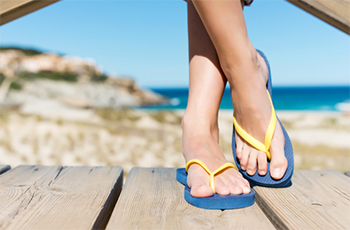
Hooray, summer has arrived! It’s the perfect time to keep your feet cool with a pair of easy-breezy flip-flops. Besides being cute and convenient, they can be pretty comfortable, too. But are flip-flops good for your feet?
The not-so-fun medical answer is ... no. Here are some reasons why:
- Many options don’t offer any heel or arch support, which means zero shock absorption.
- To keep them on your feet, your toes are forced to over-grip.
- They increase your chances of injury. (Yes, for real.) According to the Consumer Product Safety Commission, of all the emergency room visits due to shoe-related injuries in 2016, 27,000 were linked to flip-flops. They can be particularly problematic for individuals who’ve lost sensation in their feet (e.g, from diabetes or peripheral neurapathy), older adults with balance issues and young children who may be more easily tripped up or prone to catching shoes on steps or an escalator.
- Blisters, bad posture, hammertoe, athlete’s foot and other health problems can all stem from wearing flip-flops.
So if you’re a flip-flop fanatic, is all hope lost? The short answer is again, no. The long answer is, follow these tips to sidestep a flip-flop fiasco:
- If possible, buy flip-flops made of high-quality, soft leather. Brands of sandals that are known to be more foot friendly by offering features like thicker soles, arch support and wider straps are especially ideal.
- Gently bend the shoe before owning and/or wearing it. Bending just at the ball of the foot is okay, but no shoe should ever fold in half. See APMA's video for examples.
- Does the shoe fit? Your toes shouldn’t hang off the edge of flip-flops, for example. One-size-fits-all is not acceptable for your feet.
- Don’t wear the same “trusty” pair forever. Inspect older pairs for signs of wear and tear, and if necessary, discard them.
- Avoid standing around for long periods of time or walking for long distances in flip-flops. Even the best pair will offer much less arch support and cushioning than a stable athletic shoe.
- Don’t drive, play sports, run or garden/do yard work while wearing flip-flops. For activities like these, it’s best to put on something that will better protect your toes, feet and ankles.
- Stop wearing flip-flops if you notice any irritation or blisters, as these could lead to possible infection. Keep in mind, the human foot is one of the first places to show signs of serious conditions. If you're experiencing persistent foot pain, swelling, numbness or other problems, make an appointment to see your doctor or a podiatrist.
- Slather on the moisturizer and sunscreen—remember, your feet can get burned, too!
When it comes to flip-flops, practice moderation. Enjoy them responsibly at places like the beach, public swimming pools, showers or lockers room and the gym. And for symptoms that cause you concern, don't hesitate to seek professional foot care. Keep your summer feet happy all year.